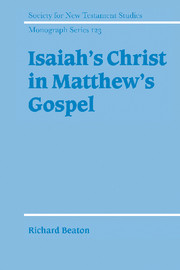Book contents
- Frontmatter
- Contents
- Preface
- List of abbreviations
- 1 Introduction
- 2 History of research
- 3 Texts and early Jewish exegesis
- 4 Isaianic formula quotations in Matthew
- 5 Isaiah 42.1–4 within the context of Matthew 11–13
- 6 The christological contribution of Isaiah 42.1–4
- 7 Conclusion
- Bibliography
- Index of passages
- Index of modern authors
- Index of subjects
4 - Isaianic formula quotations in Matthew
Published online by Cambridge University Press: 22 September 2009
- Frontmatter
- Contents
- Preface
- List of abbreviations
- 1 Introduction
- 2 History of research
- 3 Texts and early Jewish exegesis
- 4 Isaianic formula quotations in Matthew
- 5 Isaiah 42.1–4 within the context of Matthew 11–13
- 6 The christological contribution of Isaiah 42.1–4
- 7 Conclusion
- Bibliography
- Index of passages
- Index of modern authors
- Index of subjects
Summary
In chapter 3 the fluidity and variety of text-forms during the period in which Matthew worked have been illustrated and examined. This chapter will take a sounding in Matthew's use of the Old Testament in order to determine the relationship of his usage to the phenomena of the ‘non-aligned’ texts, the fluid state of the textual traditions prior to the early second century AD, and the subsequent reform movement away from the ‘freedom’ of the LXX to translations more closely aligned with the MT. Now it is time to consider the kind of text that Matthew used and how he used it. Moreover, because the particular text I shall be scrutinizing is derived from Isaiah, such an examination must take careful notice of how Matthew appears to use the text of Isaiah.
Although the following analysis will not offer an entirely new perspective, a re-examination of the data affords an opportunity to consider Matthew's text-form in the light of current models of textual transmission. I shall also consider the final form of the text, its rhetorical force and Matthew's purportedly theological usage. As was observed in chapter 2, it is methodologically unsound, particularly bearing in mind the fluid state of the text during the first century, to separate the discussion of text-form from the rhetorical force of the final form. They are interrelated. If the author is involved in editing the text, as seems likely in Matthew, then these alterations help to illuminate the theological and narrative interests of the author.
- Type
- Chapter
- Information
- Isaiah's Christ in Matthew's Gospel , pp. 86 - 121Publisher: Cambridge University PressPrint publication year: 2002



